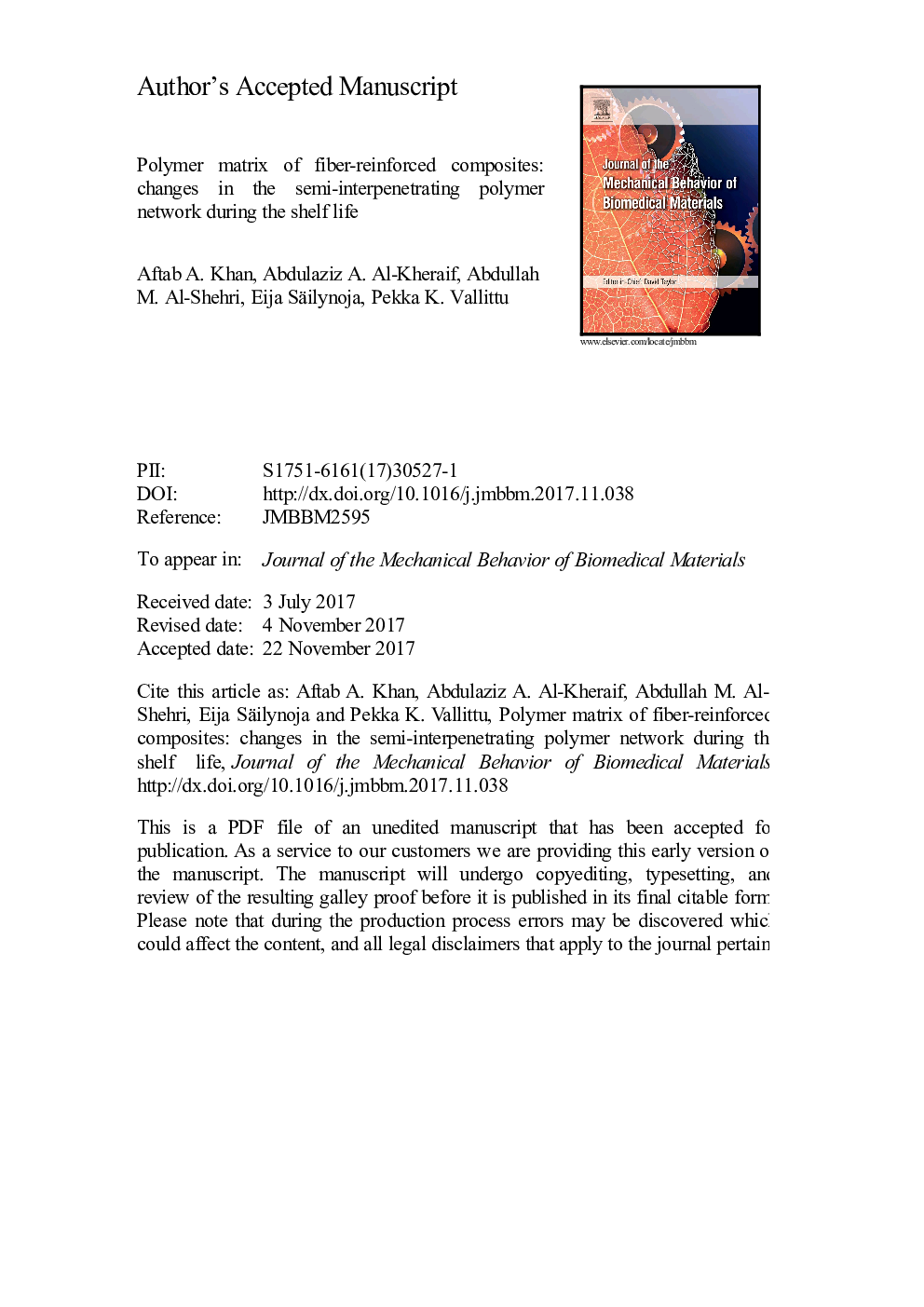| کد مقاله | کد نشریه | سال انتشار | مقاله انگلیسی | نسخه تمام متن |
|---|---|---|---|---|
| 7207340 | 1469067 | 2018 | 22 صفحه PDF | دانلود رایگان |
عنوان انگلیسی مقاله ISI
Polymer matrix of fiber-reinforced composites: Changes in the semi-interpenetrating polymer network during the shelf life
ترجمه فارسی عنوان
ماتریس پلیمر کامپوزیت های تقویت شده فیبر: تغییرات در شبکه پلیمری نیمه متقابل در طول عمر مفید
دانلود مقاله + سفارش ترجمه
دانلود مقاله ISI انگلیسی
رایگان برای ایرانیان
کلمات کلیدی
کامپوزیت تقویت شده فیبر، کامپوزیت رزین، مونومر، پلی متیل (متاکریلات)، نانوذرات، شبکه پلیمری نیمه متقابل
موضوعات مرتبط
مهندسی و علوم پایه
سایر رشته های مهندسی
مهندسی پزشکی
چکیده انگلیسی
This laboratory study was aimed to characterize semi-interpenetrating polymer network (semi-IPN) of fiber-reinforced composite (FRC) prepregs that had been stored for up to two years before curing. Resin impregnated prepregs of everStick C&B (StickTech-GC, Turku, Finland) glass FRC were stored at 4 °C for various lengths of time, i.e., two-weeks, 6-months and 2-years. Five samples from each time group were prepared with a light initiated free radical polymerization method, which were embedded to its long axis in self-curing acrylic. The nanoindentation readings on the top surface toward the core of the sample were made for five test groups, which were named as “stage 1-5”. To evaluate the nanohardness and modulus of elasticity of the polymer matrix, a total of 4 slices (100 µm each) were cut from stage 1 to stage 5. Differences in nanohardness values were evaluated with analysis of variance (ANOVA), and regression model was used to develop contributing effect of the material's different stages to the total variability in the nanomechanical properties. Additional chemical and thermal characterization of the polymer matrix structure of FRC was carried out. It was hypothesized that time of storage may have an influence on the semi-IPN polymer structure of the cured FRC. The two-way ANOVA test revealed that the storage time had no significant effect on the nanohardness of FRC (p = 0.374). However, a highly significant difference in nanohardness values was observed between the different stages of FRC (P<0.001). The regression coefficient suggests nanohardness increased on average by 0.039 GPa for every storage group. The increased nanohardness values in the core region of 6-months and 2-years stored prepregs might be due to phase-segregation of components of semi-IPN structure of FRC prepregs before their use. This may have an influence to the surface bonding properties of the cured FRC.
ناشر
Database: Elsevier - ScienceDirect (ساینس دایرکت)
Journal: Journal of the Mechanical Behavior of Biomedical Materials - Volume 78, February 2018, Pages 414-419
Journal: Journal of the Mechanical Behavior of Biomedical Materials - Volume 78, February 2018, Pages 414-419
نویسندگان
Aftab A. Khan, Abdulaziz A. Al-Kheraif, Abdullah M. Al-Shehri, Eija Säilynoja, Pekka K. Vallittu,
